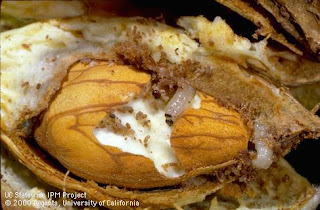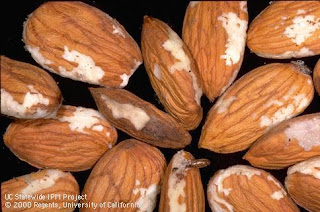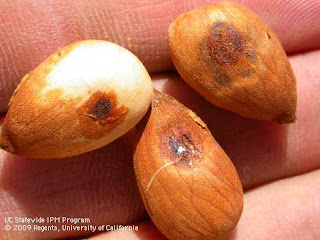Taking a harvest sample for orchard IPM check-up
Insects that cause economic damage to almond kernels include navel orange worm (NOW) (Picture 1-2), ants (Picture 3), oriental fruit moth (OFM) (Picture 4), and peach twig borer (PTB) (Picture 5), and leaffooted plant bug (Picture 6). NOW actively chews and bores through kernels, often leaving behind webbing and excessive white frass. Ants feed on the kernel skin and can hollow out kernels, leaving behind piles of “sawdust” like frass. The OFM and PTB cause similar damage on almonds, causing shallow grooves on the kernel. The only difference is that OFM leaves behind small amounts of reddish brown frass. Damage by the leafooted pant bug is noted by dark spots on the kernels.
 Picture 1: Navel Orange Worm Damage to a mature almond.
Picture 1: Navel Orange Worm Damage to a mature almond.
 Picture 2: Webbing and excessive frass left by navel orange worms.
Picture 2: Webbing and excessive frass left by navel orange worms.
 Picture 3: "Sawdust-like" frass left by ants.
Picture 3: "Sawdust-like" frass left by ants.
 Picture 4: Damage by Oriental Fruit Moth. Note the reddish frass left behind.
Picture 4: Damage by Oriental Fruit Moth. Note the reddish frass left behind.
 Picture 5: Peach Twig Borer damage found on almond kernels. Note the lack of frass and shallow grooves.
Picture 5: Peach Twig Borer damage found on almond kernels. Note the lack of frass and shallow grooves.

Picture 6: Darkened spots caused by the leaf-footed plant bug.
